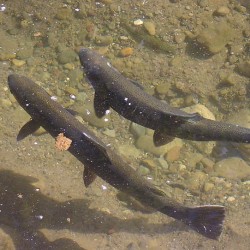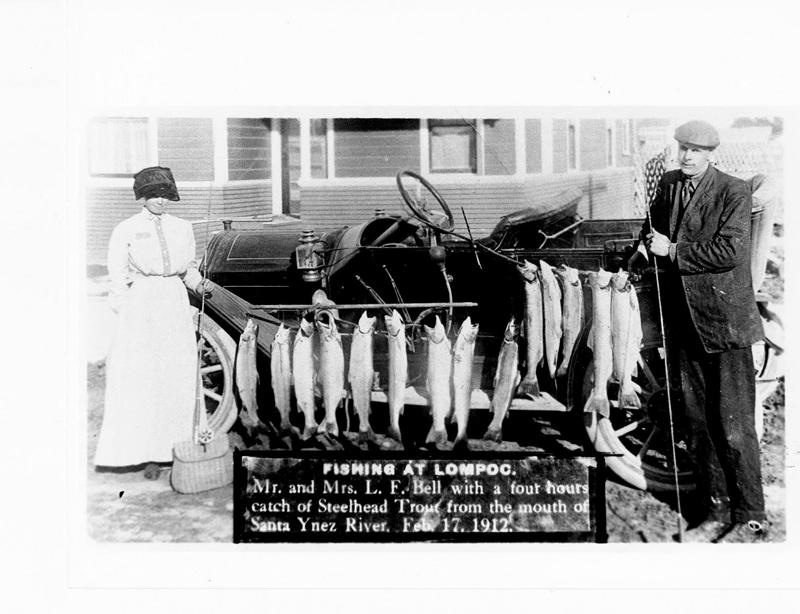
A Voice for Steelhead

Photo by Mark Capelli
The Environmental Defense Center recently achieved a successful settlement with the U.S. Bureau of Reclamation on behalf of our watershed and fish advocacy client California Trout. We sued Reclamation a little over a year ago for its failure to comply with its obligations under the Endangered Species Act to protect the few remaining federally endangered Southern California steelhead in our region that live in Hilton Creek, a tributary of the Santa Ynez River just below Bradbury Dam.
Speaking of dams, if you haven’t seen the documentary DamNation I strongly encourage you to watch it. It’s not just informative about the history of our country’s infatuation with building dams in the early to mid-twentieth century and the havoc they’ve wreaked on wild fish populations, but it also provides a moving and touching portrait of the fish themselves. While the salmon and steelhead profiled are not the “charismatic megafauna” that often garner concerned attention – they’re not fuzzy and cute like polar bears – they are truly amazing creatures. The film does a fine job of conveying their beauty, the cultures that have been intertwined with their existence, and the incredible life cycle that brings them from hatching in freshwater streams to the ocean and back to those same freshwater streams to spawn their own young. And of course, the film describes the plight they have faced due to our over-simplistic reliance on dams as tools for water storage and flood protection.
The film has a particularly touching scene profiling a humble naturalist who spends much of his life observing Northern Umpqua Steelhead on Steamboat Creek, a tributary of the North Umpqua River in Oregon. Steelhead are protected there and sadly this is one of the few remaining places where wild steelhead still have access to such protected spawning grounds. The naturalist has a great line, “wild fish are the real deal….the great beauty of wild fish is that we don’t have to do a []damn thing for them, except to leave them the hell alone.” Unfortunately, this doesn’t seem easy enough to accomplish.

1912 photo of steelhead from the Santa Ynez River. Photo from the Lompoc Valley Historical Society
The line particularly struck me given EDC’s recent work to protect endangered steelhead. The Southern California branch of the majestic steelhead line long dominated this area, where early-twentieth century murals around Lompoc paid homage to the popular fishing of huge steelhead on the Santa Ynez River. The fish were also always an integral part of local Chumash cultural history. Tens of thousands of steelhead, like their better-known salmon cousins more common in the north, made the journey from the freshwater streams of the Santa Ynez out to the ocean and back again. These fish were well adapted to the fluctuating water conditions of this drier region. Upstream habitat in the Santa Ynez Mountains, where the water flowed year round, enabled them to wait out dry periods like we have now. This habitat is now entirely inaccessible to the fish due to Bradbury Dam, built in 1953.
Due to Bradbury Dam’s impacts and pursuant to the Endangered Species Act, Reclamation is required to release water into Hilton Creek to ensure adequate flows for steelhead to migrate, spawn and mature and to ensure that the fish does not fall further into jeopardy of extinction. However, the Hilton Creek watering system and faulty pumps failed to work properly on numerous occasions beginning in early 2013, resulting in Hilton Creek running dry multiple times. These failures led to the deaths of at least 393 steelhead and necessitated the stressful capture and rescue of at least another 634 stranded fish. After multiple delays in even starting to fix the pumps and watering system, California Trout brought this lawsuit against Reclamation alleging violations of the Endangered Species Act, and seeking an expeditious fix to the system.
Over the course of our work to protect steelhead, I’ve heard a lot of “fish vs. people” rhetoric. Comments like why don’t they just let the fish die, they would have anyway in this drought and why are we wasting our precious little remaining water on fish. The lack of understanding displayed in these comments is disappointing. In the first place, such comments often reflect misconceptions – for example, as described, with access to their native upstream habitat, these fish were and still are well-adapted to dry periods and would actually survive in dry times like these. In addition, the water released into Hilton Creek to help steelhead maintain some semblance of spawning habitat rejoins the main stem of the Santa Ynez, where it provides water to downstream water users. But moreover, such comments fail to consider that these fish were here – making their journey from their native streams to the ocean and back – long before we were. And, that if we hadn’t built Bradbury Dam, we wouldn’t have to do a thing for them, except leave them alone. But because of the dam, and the massive steelhead population destruction it caused, we didn’t leave them alone, and we are now obligated to help them avoid complete extinction.
Our settlement requires among other things, that Reclamation complete repairs and upgrades to the Hilton Creek watering system by January 31, 2016. It also requires Reclamation to explore the possibility of a implementing a permanent, gravity-fed system of watering Hilton Creek, which would be inherently more reliable than mechanical systems of water release that are inherently subject to failures.
While pumps releasing water into a relatively small habitat to help the species hobble along may seem to some futile, or even wasteful, I contend it’s the least we can do to atone for what we have done to these fish. We should of course do much more, like provide fish passage or a fish ladder over the dam so the fish have some chance to reach their historic habitat. EDC and California Trout continue to work towards encouraging these types of solutions – solutions that both recognize the need for Bradbury Dam and the reservoir it created, but which would also help the fish to thrive again one day. But until we implement such solutions – until the steelhead have recovered to the point that we can just “leave them the hell alone” – our settlement at least ensures that the lifeline provided to these magnificent fish through Hilton Creek will be as reliable as possible. And of course, I hope to one day see the dazzling scene of thousands of steelhead making their journey up and down the Santa Ynez River.
Tags: Bradbury Dam, Endangered Species Act, federally listed, Hilton Creek, keystone species, Santa Ynez River, steelhead, trout
Trackback from your site.






Erik Schmidt
| #
Very nicely written and thoughtful story, Nicole. Thanks for your work on steelhead habitat and other issues at EDC.
Reply
voir film streaming francais
| #
voir film streaming francais
A Voice for Steelhead » Environmental Defense Center
Reply